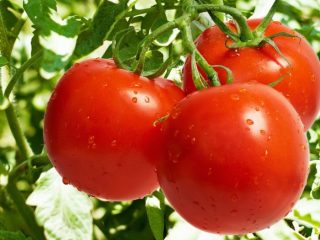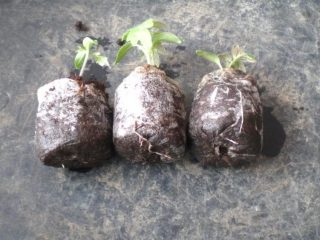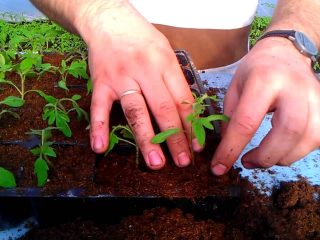Content
- 1 Who brought it out and when?
- 2 Description of the tomato variety Blue Spruce
- 3 Characteristics of Blue Spruce tomato
- 4 Advantages and disadvantages
- 5 Planting seedlings and planting in the ground
- 6 Outdoor care
- 7 Treatment against diseases and pests
- 8 Conclusion
- 9 Reviews from gardeners about the Blue Spruce tomato variety
The Blue Spruce tomato is an ornamental variety that is designed for growing indoors. Its positive characteristics and varietal characteristics can satisfy the requirements of any gardener. It is important to familiarize yourself with planting technology and recommendations for caring for this crop.
Who brought it out and when?
The Blue Spruce variety was developed by Russian breeders. This event happened in Siberia about 10 years ago. The tomato develops correctly and bears fruit consistently in any region, even with a cold climate. The task was to obtain a species resistant to adverse factors. And Blue Spruce fully met all expectations.

In the south of the country, Blue Spruce tomatoes perform well in garden beds, although they are intended for growing in greenhouses
Description of the tomato variety Blue Spruce
The Blue Spruce tomato variety, a description and photo of which is presented below, is a medium-sized (semi-determinate) bush. Its height varies from 1.5 to 1.7 meters.The leaves and shoots have a bluish-green color.
Blue spruce tomatoes are medium in size and weigh 100-150 g. They are endowed with a round or oval shape. Their flesh is fleshy, dense, but juicy. The taste is dominated by sweetness and there is a slight sour note.

Tomato skins are not prone to cracking
Characteristics of Blue Spruce tomato
It will be useful for all those who are just beginning to get acquainted with the Blue Spruce tomato variety to study its characteristics. Typically, gardeners are interested in its yield and resistance to diseases. It would be useful to learn about its advantages and disadvantages.
Ripening and fruiting
The Blue Spruce variety is a mid-season vegetable crop: the first tomatoes can be harvested in 105-125 days. To speed up the ripening time, you need to choose an open sunny place for planting tomatoes.
Blue spruce tomato yield
The yield of the variety is high, but only with proper care. Then from one square meter you will be able to collect 8 kg of selected fruits. Tomatoes can be ripened at home.

Fruits do not wrinkle when transported over long distances
Disease resistance
Blue spruce tomatoes are characterized by good immunity to many diseases, including late blight. When the first signs of the disease appear, it is necessary to urgently treat the plants with a solution containing copper. This will help maintain the tomato harvest at a decent level.
Growing regions
Due to its good characteristics, Blue Spruce tomatoes can be grown in any region. The conditions of the middle zone and the climate of the northern regions with cold and long winters are suitable for it.
Methods of application
There are no restrictions on the use of these tomatoes. They are suitable for fresh eating, making salads and sauces. Harvest residues can be processed into juices. In any form, the fruits are very healthy and tasty.
Advantages and disadvantages
Blue spruce tomatoes have won the respect of gardeners due to their unusual appearance and good taste.

The harvest is characterized by high shelf life and transportability
Pros:
- strong immunity;
- excellent adaptation to different growth conditions;
- ease of care;
- versatility of use;
- decorativeness of bushes;
- high yield rates;
- resistance to dangerous diseases;
- preservation of taste when ripening at home.
Minuses:
- needs regular feeding;
- bushes require tying, shaping and pinching;
- judging by the reviews, the pubescence of the fruit causes discomfort when consumed by many.
Planting seedlings and planting in the ground
Blue spruce seeds are sown 60-65 days before planting in the ground. A single container is filled with the nutrient substrate. Then the seeds are distributed over the surface, buried 1 cm and sprinkled with a thin layer of substrate. Next, the soil is irrigated with a spray bottle and the container is covered with transparent glass. Place in a warm place and remove the glass when sprouts appear.
To harden, seedlings are taken outside first for 40 minutes, then for 1-2 hours. Tomatoes are planted in open ground at the end of May or beginning of June. At this time, as a rule, frosts do not return.Plants are planted in previously prepared and fertilized soil according to a 50x70 cm pattern. The roots are covered with soil, watered and mulched.

Seedlings are removed from containers after abundant watering along with a lump of earth
Outdoor care
The tomato will develop well and bear fruit abundantly in favorable conditions. Watering is carried out with warm soft water. Their frequency depends on the climate and weather of the region. On average, bushes are watered 1-2 times a week. During drought and heat, watering is done every day in the evening, when there is no longer sun.
After watering, the soil is loosened for better air and water permeability. This also facilitates the full penetration of microelements into the root system, which allows it to develop quickly.
After weeding, the area under the tomatoes is covered with mulch. This could be straw, peat, sawdust or dry grass. A layer of mulch material helps maintain an increased level of moisture in the soil and enrich it with nutrients.
This tomato requires fertilizing, which is applied 3-4 times throughout the season. Organic matter is alternated with mineral fertilizers so that the plants receive all the necessary substances. Young seedlings require nitrogen fertilizers during the growing season. After flowering, potassium-phosphorus supplements are added. They are responsible for the taste of the fruit.
To increase productivity, tomatoes are formed into one stem. However, when cultivating the variety in a greenhouse, farmers prefer a double stem. This way, condensation does not accumulate in the thick foliage.The shoots are tied to stakes to prevent deformation under the weight of the fruit.
Treatment against diseases and pests
The Blue Spruce variety is naturally endowed with strong immunity. With good care, it is not afraid of infections such as Alternaria, Fusarium and Cladosporiosis.

During the rainy season and if agricultural practices are violated, tomato bushes may suffer from various rots and fungi
The tomato is relatively resistant to late blight. When carrying out preventive measures, including disinfection of the soil in the greenhouse, it will be possible to save the harvest. It is best to treat bushes with a 1% solution of Bordeaux mixture.
Tomatoes are often attacked by aphids, especially if the summer is hot. Contact insecticides or soap- and tobacco-based solutions help control the pest. When growing bushes in greenhouses, whiteflies and spider mites may appear.

It is mandatory to trim old leaves, especially in the lower part of the bush.
Conclusion
The Blue Spruce tomato adapts perfectly to any climatic conditions, is rarely affected by diseases and is attacked by pests. The bushes are suitable for growing both in open ground and in greenhouse conditions. A distinctive feature of the variety is the dense pubescence of all parts of the plant, including the fruits.
Reviews from gardeners about the Blue Spruce tomato variety








